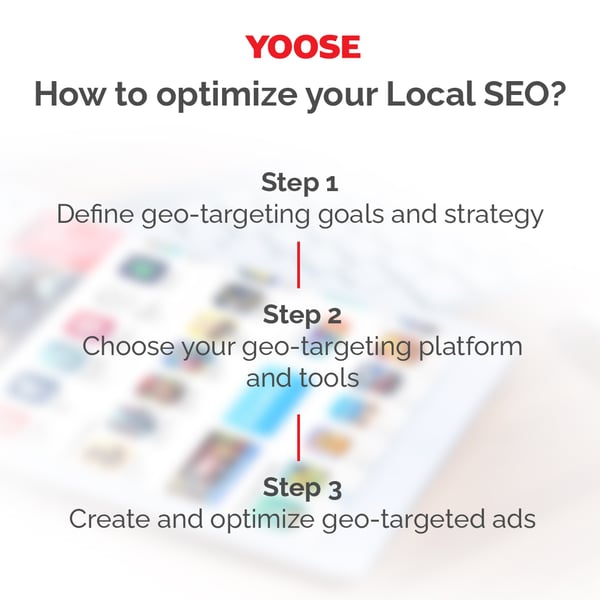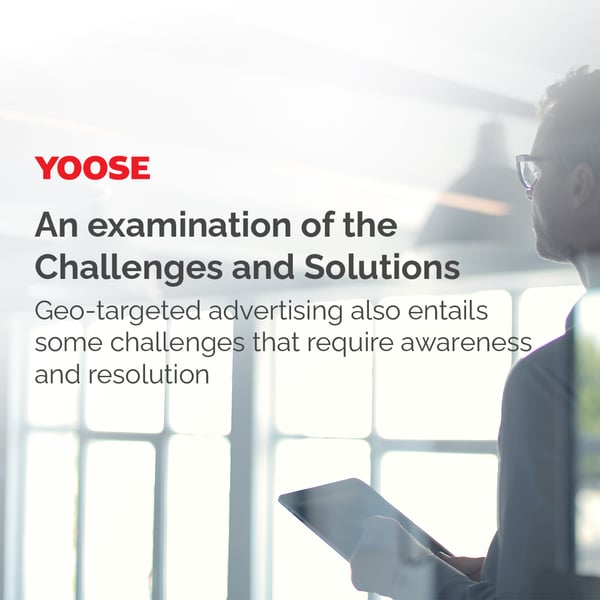How to Master Geo-Targeted Advertising for Your Business: A Comprehensive Tutorial
Geo-targeted advertising is a marketing strategy that can enhance the effectiveness and efficiency of your campaigns. This blog aims to provide a comprehensive overview of geo-targeted advertising, including its definition, implementation, benefits, and challenges. The following sections will elaborate on these aspects in detail.
What is geo-targeted advertising?
Geo-targeted advertising is a marketing strategy that uses location data to deliver personalized ads to potential customers based on their geographic area. It allows advertisers to reach consumers who are more likely to be interested in their products or services, and to optimize their campaigns for better performance and return on investment.

Geo-targeted advertising can be implemented through various channels, such as search engines, social media, mobile apps, websites, and email. For example, a local pizza shop can use geo-targeted advertising to show ads to people who are within a certain radius of their store, and offer them a discount coupon or a free delivery option.
How to implement geo-targeted advertising?
Step 1: Define geo-targeting goals and strategy
Before you start creating your geo-targeted ads, you need to have a clear idea of what you want to achieve and how you will measure your success. Some common goals for geo-targeting are:
- Increase brand awareness in a new market.
- Drive more traffic to your local store or website.
- Promote a special offer or event in a specific region.
- Boost sales of a product or service that is relevant to a certain location.
Once you have your goals, you need to define your strategy for reaching them. This includes:
- Choosing the geographic areas that you want to target.
- Segmenting your audience based on their location, language, and behavior.
- Creating relevant and engaging ad copy and creative for each segment.
- Setting up your budget and bidding strategy for each campaign.
Step 2: Choose your geo-targeting platform and tools
There are many platforms and tools that you can use to implement geo-targeted advertising, depending on your goals and budget. Some of the most popular ones are:
- Google Ads: Google Ads is the most extensive online advertising network that enables the creation and execution of geo-targeted advertisements on Google Search, Display, YouTube, and Maps. Google Ads allows advertisers to segment their audience by geographical criteria such as country, region, city, zip code, or radius around a location. Additionally, advertisers can utilize location extensions to display their address, phone number, and directions to their store on their advertisements.
- Facebook Ads: Facebook Ads is another influential platform that facilitates the creation and execution of geo-targeted advertisements on Facebook, Instagram, Messenger, and Audience Network. Facebook Ads permits advertisers to segment their audience by geographical criteria such as country, state, city, zip code, or radius around a location. Moreover, advertisers can employ dynamic ads to exhibit personalized products or services based on the user’s location.
- Bing Ads: Bing Ads is analogous to Google Ads but it operates on the Bing search engine and its partner sites. Bing Ads enables advertisers to segment their audience by geographical criteria such as country, state, city, zip code, or radius around a location. Furthermore, advertisers can utilize location extensions to display their address, phone number, and directions to their store on their advertisements.
- Other platforms and tools: There are numerous other platforms and tools that can be used to implement geo-targeted advertising, such as Twitter Ads, LinkedIn Ads, Snapchat Ads, Pinterest Ads, Yelp Ads, Waze Ads, Foursquare Ads, etc. Each platform has its own features and benefits that should be explored and compared before selecting the most suitable one for the advertiser’s objectives.
Step 3: Create and optimize geo-targeted ads
Once you have chosen your platform and tools, you can start creating your geo-targeted ads. Here are some tips to make sure your ads are effective and relevant:
- Use keywords that match the user's intent and location. For example, if you are targeting users who are looking for pizza delivery in New York City, you should use keywords like "pizza delivery NYC", "best pizza near me", "pizza delivery in Manhattan", etc.
- Use ad copy and creative that appeal to the user's location, language, and culture. For instance, if the target audience is users who speak Spanish in Miami, the ad copy and creative should be composed in Spanish and reflect the local culture and preferences of Miami residents.
- Use landing pages that are optimized for the user's location. If you are targeting users who are interested in buying shoes in London, you can use landing pages that show the prices in pounds sterling, the shipping options for the UK, and the customer reviews from London customers.


Why is geo-targeted advertising important?
Geo-targeted advertising can enable you to accomplish the following objectives:
- Reach the right audience: By targeting your ads based on location, you can ensure that you are reaching people who are more likely to be interested in your products or services. For example, if you are a local restaurant, you can target people who are within a certain radius of your location, or who have searched for nearby restaurants on their devices. This way, you can avoid wasting your ad budget on people who are too far away or who have different preferences.
- Increase relevance and engagement: By tailoring your ads to the specific needs and interests of your audience based on their location, you can increase the relevance and engagement of your ads. For example, if you are a clothing retailer, you can customize your ads based on the weather, season, or local events in different regions. This way, you can show your audience that you understand their needs and offer them solutions that match their context.
- Boost conversion rates and sales: By delivering timely and personalized ads to your audience based on their location, you can boost your conversion rates and sales. For example, if you are a travel agency, you can target people who are in airports or hotels with special offers or discounts for your services. This way, you can capture their attention and motivate them to take action while they are in a travel mindset.
- Enhance brand awareness and loyalty: By creating a positive and memorable experience for your audience with geo-targeted ads, you can enhance your brand awareness and loyalty. For example, if you are a coffee shop, you can target people who are near your competitors with ads that highlight your unique value proposition or customer reviews. This way, you can differentiate yourself from your competitors and encourage your audience to choose you over them.

An examination of the Challenges and Solutions
Geo-targeted advertising also entails some challenges that require awareness and resolution.

- Privacy and consent: Geo-targeting requires access to the location data of your audience, which may raise privacy and consent issues. You need to ensure that you comply with the relevant laws and regulations regarding data protection and privacy in different regions. You also need to obtain explicit consent from your audience before collecting and using their location data. You can do this by using clear and transparent opt-in mechanisms, such as pop-ups or banners, that explain how and why you use their location data.
- Accuracy and reliability: Geo-targeting relies on the accuracy and reliability of the location data that is employed, which may differ depending on the source and method of collection. It is essential to ensure that high-quality and up-to-date location data from reputable providers or platforms is used. It is also necessary to evaluate and optimize the geo-targeting campaigns regularly to ensure that they are achieving the intended outcomes.
- Competition and saturation: Geo-targeting may increase the competition and saturation of the ad space in certain locations, especially in densely populated or popular areas. You need to ensure that you stand out from the crowd by creating compelling and creative ads that capture the attention of your audience. You also need to monitor and adjust your ad budget and bid strategy accordingly to optimize your return on investment.

How to optimize geo-targeted advertising campaign
Here are some tips on how to optimize geo-targeted advertising:- Use location-specific keywords and phrases in your ad copy and landing pages. Your target audience will be drawn to you and see that you are aware of their requirements and preferences if you do this.
- Segment your audience by different geographic criteria, such as country, region, city, zip code, or radius. This will help you tailor your ads to different markets and offer them customized solutions or offers.
- Test and measure your geo-targeted campaigns using analytics tools and metrics, such as impressions, clicks, conversions, cost per action, and return on ad spend. By doing this, you can determine what works best in each area and adjust your budget and performance as necessary.
- Use dynamic creative optimization (DCO) to automatically adjust your ad content and design based on the location of the user. You can utilize this to make adverts that are more interesting and pertinent to the user's context and intent.
- Leverage geo-fencing and geo-conquesting techniques to target users who are near your physical store or your competitors' locations. You'll be able to enhance revenue, brand recognition, and foot traffic with this.

Some real case studies of Geo-targeted advertising
Starbucks
Challenge: Starbucks wanted to boost its sales during the holiday season and promote its seasonal drinks and gift cards.
Solution: Starbucks used geo-targeted ads on Facebook and Instagram to target users who were within a certain radius of its stores. The ads featured creative images and videos of the holiday drinks and gift cards, as well as a call-to-action button that directed users to the nearest store or to the online store.
Result: Starbucks reported that the geo-targeted campaign generated a 3x return on ad spend and a 17% increase in store visits.
IKEA
Challenge: IKEA wanted to increase its brand awareness and store traffic in a new market where it faced strong competition from local furniture retailers.
Solution: IKEA used geo-targeted ads on Google and YouTube to target users who were searching for furniture keywords or watching home improvement videos in the new market. The ads showcased IKEA's unique value proposition, such as its low prices, quality products and design services. The ads also included a map that showed the location of the nearest IKEA store and a link to the online catalog.
Result: IKEA reported that the geo-targeted campaign generated a 31% increase in brand awareness and a 25% increase in store visits.
Nike
Challenge: Nike wanted to launch its new Air Max 270 sneakers and create a buzz among its target audience of young and urban consumers.
Solution: Nike used geo-targeted ads on Snapchat to target users who were in or near selected cities around the world. The ads featured an interactive lens that allowed users to try on the sneakers virtually and see how they looked from different angles. The ads also encouraged users to share their snaps with their friends and to visit the Nike website or app to buy the sneakers.
Result: Nike reported that the geo-targeted campaign generated a 6x increase in engagement and a 4x increase in sales.
Conclusion
Geo-targeted advertising enables you to reach and engage your audience based on their location. It also requires planning, execution, and optimization to overcome privacy, accuracy, and competition challenges. At YOOSE, we know how to employ the tips and best practices to optimize geo-targeted advertising campaigns and objectives.
If you want to learn more about geo-targeted advertising or get professional help, please contact us today. YOOSE will help you grow your business with geo-targeted advertising.


